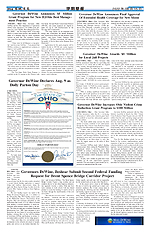|
 |
哥伦布、匹兹堡及各地消息
|
| |
Governors DeWine, Beshear Submit Second
Federal Funding Request for Brent Spence
Bridge Corridor Project
|

|
(COLUMBUS,
Ohio)—Ohio Governor Mike DeWine and Kentucky Governor Andy Beshear
announced today that the two states jointly submitted a second
federal funding application to support bridge and roadway
improvements along the eight-mile Brent Spence Bridge Corridor from
the Western Hills Viaduct in Ohio to Dixie Highway in Kentucky.
The new funding request was made to the Bridge Investment Program
and is in addition to the still-pending May 2022 funding request
made to the Multimodal Projects Discretionary Grant Program. Ohio
and Kentucky articulated in both applications that a total of $1.66
billion in federal grant funding is needed regardless of which
discretionary grant program awards funds to the project. The states
are applying to multiple Bipartisan Infrastructure Law (BIL) grant
programs to give themselves the best chance of receiving maximum
funding, a strategy that is in line with the pledges of Governors
DeWine and Beshear to pursue every federal dollar available for this
bridge project.
“Now, more than ever, our national economy depends on the efficient
movement of people, goods, and services on our federal Interstate
System,” said Governor DeWine. “The Brent Spence Bridge Corridor
Project is long overdue, and our residents deserve to have these
highway infrastructure upgrades become a reality. Ohio and Kentucky
continue to work closely with our federal partners to secure the
funding we need to invest in our future through the transformation
of this critical corridor."
“The time for us to act is now,” said Governor Beshear. “Kentucky
and Ohio are working with our partners to ensure we have the funding
we need to complete improvements along the Brent Spence Bridge
corridor. There is a tremendous sense of urgency surrounding this
project because we recognize how important it is for the people we
serve. I want us to be able to break ground next year.”
The Brent Spence Bridge Corridor Project calls for the construction
of a companion bridge to the west of the existing Brent Spence
Bridge, as well as improvements to the current bridge and the
roadway network that ties into each river crossing. Ohio and
Kentucky will share the cost of the new bridge equally, and each
state will be responsible for the needed work on its side of the
Ohio River.
As the project moves closer to full funding, the pace of activity
has picked up to ensure construction readiness. The bi-state project
team is prioritizing the following activities while the federal
funding requests are under review:
Updating the financial plan to align with existing funding
opportunities and anticipated project needs, including evaluation of
the potential impacts of inflation on the funding plans for each
state;
-Continuing development of the revised concept for the new companion
bridge, which significantly improves safety by separating through
and local traffic;
-Analyzing potential options for construction using the design/build
process; and
-Performing environmental field work, including updating air and
noise evaluations.
-About the Brent Spence Bridge Corridor Project
Fueled by bipartisan cooperation and community engagement, the
Brent Spence Bridge Corridor Project will invest in local
communities and help grow America’s economy. Spanning eight miles
between the Western Hills Viaduct in Ohio and Dixie Highway in
Kentucky, the project will address the second-worst truck bottleneck
in the nation by improving safety and travel on the interstate
connection that carries more than $700 billion worth of freight
every year.
In addition, the project will improve access to the central
business districts of Cincinnati, Ohio, and Covington, Kentucky, and
will also support local businesses and underserved communities in
historic neighborhoods on both sides of the river. Ohio and Kentucky
are working together to deliver this transformative project that
will improve the quality of life for the millions of Americans who
use the federal highway system to travel between the two states and
beyond.
|
| |
|
 |
| |
| |
| |
| |
| |
| |
| |
| |
| |
| |
| |
| |
| |
| |
| |
| |
| |
| |
| |
| |
| |
| |
| |
| |
| |
| |
| |
| |
| |
| |
| |
| |
| |
| |
| |
| |
| |
| |
| |
| |
| |
| |
| |
| |
|